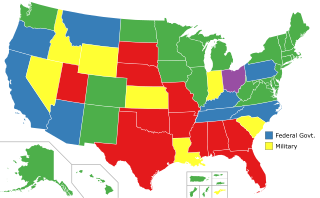Related Research Articles
Capital punishment, also known as the death penalty and formerly called judicial homicide, is the state-sanctioned killing of a person as punishment for actual or supposed misconduct. The sentence ordering that an offender be punished in such a manner is known as a death sentence, and the act of carrying out the sentence is known as an execution. A prisoner who has been sentenced to death and awaits execution is condemned and is commonly referred to as being "on death row". Etymologically, the term capital refers to execution by beheading, but executions are carried out by many methods, including hanging, shooting, lethal injection, stoning, electrocution, and gassing.

Sodium thiopental, also known as Sodium Pentothal, thiopental, thiopentone, or Trapanal, is a rapid-onset short-acting barbiturate general anesthetic. It is the thiobarbiturate analog of pentobarbital, and an analog of thiobarbital. Sodium thiopental was a core medicine in the World Health Organization's List of Essential Medicines, but was supplanted by propofol. Despite this, thiopental is listed as an acceptable alternative to propofol, depending on local availability and cost of these agents. It was the first of three drugs administered during most lethal injections in the United States until the US division of Hospira objected and stopped manufacturing the drug in 2011, and the European Union banned the export of the drug for this purpose. Although thiopental abuse carries a dependency risk, its recreational use is rare.

Lethal injection is the practice of injecting one or more drugs into a person for the express purpose of causing rapid death. The main application for this procedure is capital punishment, but the term may also be applied in a broader sense to include euthanasia and other forms of suicide. The drugs cause the person to become unconscious, stops their breathing, and causes a heart arrhythmia, in that order.

The electric chair is a specialized device used for capital punishment through electrocution. The condemned is strapped to a custom wooden chair and electrocuted via electrodes attached to the head and leg. Alfred P. Southwick, a Buffalo, New York dentist, conceived this execution method in 1881. It was developed over the next decade as a more humane alternative to conventional executions, particularly hanging. First used in 1890, the electric chair became symbolic of this execution method.

Execution by firing squad, in the past sometimes called fusillading, is a method of capital punishment, particularly common in the military and in times of war. Some reasons for its use are that firearms are usually readily available and a gunshot to a vital organ, such as the brain or heart, most often will kill relatively quickly.

In the United States, capital punishment is a legal penalty in 27 states, throughout the country at the federal level, and in American Samoa. It is also a legal penalty for some military offenses. Capital punishment has been abolished in the other 23 states and in the federal capital, Washington, D.C. It is usually applied for only the most serious crimes, such as aggravated murder. Although it is a legal penalty in 27 states, 20 of them have authority to execute death sentences, with the other 7, as well as the federal government and military, subject to moratoriums.

Capital punishment is not allowed to be carried out in the U.S. state of California, due to both a standing 2006 federal court order against the practice and a 2019 moratorium on executions ordered by Governor Gavin Newsom. The litigation resulting in the court order has been on hold since the promulgation of the moratorium. Should the moratorium end and the freeze conclude, executions could resume under the current state law.

Capital punishment is a legal penalty in the U.S. state of Ohio, although all executions have been suspended indefinitely by Governor Mike DeWine until a replacement for lethal injection is chosen by the Ohio General Assembly. The last execution in the state was in July 2018, when Robert J. Van Hook was executed via lethal injection for murder.
Capital punishment is a legal penalty in the U.S. state of Nebraska. In 2015, the state legislature voted to repeal the death penalty, overriding governor Pete Ricketts' veto. However, a petition drive secured enough signatures to suspend the repeal until a public vote. In the November 2016 general election, voters rejected the repeal measure, preserving capital punishment in the state. Nebraska currently has 11 inmates on death row.
Capital punishment is a legal penalty in the U.S. state of Oklahoma.
Pentobarbital (US) or pentobarbitone is a short-acting barbiturate typically used as a sedative, a preanesthetic, and to control convulsions in emergencies. It can also be used for short-term treatment of insomnia but has been largely replaced by the benzodiazepine family of drugs.
Frances Elaine Newton was an American convicted murderer who was executed by lethal injection in the state of Texas for the April 7, 1987 murder of her husband, Adrian, age 23, her son, Alton, age 7, and her daughter, Farrah, 21 months.

Capital punishment is a legal penalty in the U.S. state of Texas for murder, and participation in a felony resulting in death if committed by an individual who has attained or is over the age of 18.

Hospira was an American global pharmaceutical and medical device company with headquarters in Lake Forest, Illinois. It had approximately 19,000 employees. Before its acquisition by Pfizer, Hospira was the world's largest producer of generic injectable pharmaceuticals, manufacturing generic acute-care and oncology injectables, as well as integrated infusion therapy and medication management systems. Hospira's products are used by hospitals and alternate site providers, such as clinics, home healthcare providers and long-term care facilities. It was formerly the hospital products division of Abbott Laboratories. On September 3, 2015, Hospira was acquired by Pfizer, who subsequently sold off the medical devices portion of Hospira to ICU Medical.
Kenneth Biros was an American convicted murderer who was sentenced to death and executed for the aggravated murder, attempted rape, aggravated robbery and felonious sexual penetration of a young woman. Biros was the first condemned person to be executed by lethal injection in the United States with the use of a single drug, setting a Guinness World Record.
Participation of medical professionals in American executions is a controversial topic, due to its moral and legal implications. The practice is proscribed by the American Medical Association, as defined in its Code of Medical Ethics. The American Society of Anesthesiologists endorses this position, stating that lethal injections "can never conform to the science, art and practice of anesthesiology".

Albert Greenwood Brown Jr. is an American murderer and rapist who has been convicted of sexual molestation with force of a minor, two counts of first-degree rape with force, and the first degree murder of a teen girl in Riverside, California.
Capital punishment is a legal penalty in the U.S. state of Arizona. 95 executions have been carried out since Arizona became a state in 1914 and there are currently 111 people on death row. In November 2024, Attorney General Kris Mayes announced that the state would resume executions in 2025 after a 2-year pause.
Capital punishment is a legal penalty in the U.S. state of Montana.
References
- 1 2 Pilkington, Ed (2015-04-29). "'It's problematic': inventor of US lethal injection reveals death penalty doubts". The Guardian. Retrieved 2021-09-13.
- ↑ ""U.S., Index to Public Records, 1994-2018"", Ancestry.com
- ↑ Boyer Sagert, Kelly (2007). The 1970s . Westport, Conn.: Greenwood Press. pp. 37–38. ISBN 978-0-313-33919-6.
- ↑ Grady, Denise (2006-06-23). "Doctors See Way to Cut Suffering in Executions". The New York Times. Retrieved 2009-12-11.
- 1 2 Kutner, Max (2017-05-01). "Lethal injection inventor A. Jay Chapman: "I wish I had never been asked" to create it". Newsweek. Retrieved 2021-09-13.
- ↑ Jacquette, Dale (2009). Dialogues on the Ethics of Capital Punishment (New Dialogues in Philosophy) . Rowman Littlefield Publishers, Inc. pp. 98–99. ISBN 978-0-7425-6143-4.